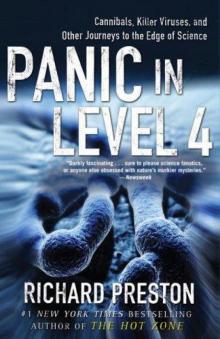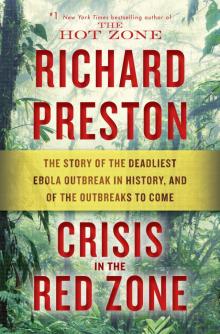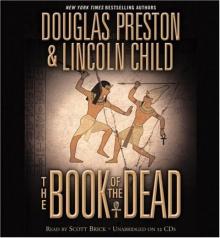- Home
- Richard Preston
Crisis in the Red Zone
Crisis in the Red Zone Read online
Copyright © 2019 by Richard Preston
Map copyright © 2019 by Mapping Specialists Ltd.
All rights reserved.
Published in the United States by Random House, an imprint and division of Penguin Random House LLC, New York.
RANDOM HOUSE and the HOUSE colophon are registered trademarks of Penguin Random House LLC.
Portions of this book first appeared in The New Yorker in somewhat different form.
Grateful acknowledgment is made to the following for permission to use previously unpublished material:
Jean-François Ruppol: Excerpts from an unpublished journal entitled “Ebola 2” by Jean-François Ruppol. Reprinted by permission of the author.
Nadia Wauquier: Excerpts from an unpublished journal entitled “Ebola Diary” by Nadia Wauquier. Reprinted by permission of the author.
LIBRARY OF CONGRESS CATALOGING-IN-PUBLICATION DATA
Names: Preston, Richard, author.
Title: Crisis in the red zone : the story of the deadliest Ebola outbreak in history, and of the outbreaks to come / by Richard Preston.
Description: First edition. | New York : Random House, [2019]
Identifiers: LCCN 2019010492 | ISBN 9780812998832 | ISBN 9780812998849 (ebook)
Subjects: | MESH: Hemorrhagic Fever, Ebola—history | Hemorrhagic Fever, Ebola—epidemiology | Disease Outbreaks—history | International Cooperation—history | History, 21st Century
Classification: LCC RA644.E26 | NLM WC 534 | DDC 614.5/7—dc23 LC record available at https://lccn.loc.gov/2019010492
Ebook ISBN 9780812998849
randomhousebooks.com
Book design by Susan Turner, adapted for ebook
Cover design: Carlos Beltrán
Cover photograph: Matteo Colombo/Getty Images
v5.4_r1
ep
Contents
Cover
Title Page
Copyright
Epigraph
Preface
Map of the Makona Triangle
Selected Persons
Abbreviations
Part One: Nameless
Sacrament
Road’s End
Life Form
Knife
Flight
Part Two: Heat Lightning
The Washing Pool
The Woman with Almond Eyes
Identification
Lisa Hensley
Red Zone
The Doctor
Sabeti
Surveillance
Flash
Breathing Unit
The Snake of Menindor
America
Dark Wings
Rain
War Room
Violence
Bedtime
Ambush
Flip-Flops
Speech
Teardrop
Swarm
Blood Draws
Fonnie
A Prophet and a Vision
Rescuing Lucy May
Candle Flame
Part Three: The Ancient Rule
Journey to Kinshasa
Bush Doctor
The Ancient Rule
X Virus
A Hole in the Night
The Zárate Procedure
Bleedout
Part Four: Crisis in the Red Zone
Situation Report
Spittoon
Magic Sword
Wow
Confession
The Smoking Place
Caller I.D.
Screams
Last Offices
Freezer
Potter’s Field
Teleconference
Nightfall
Justice
Father and Daughter
Milky Way
Surf
Argument
Flight
Hidden Path
Crash
Terror
Cured
The Chain of Care
Epilogue
Glossary
Dedication
Acknowledgments
By Richard Preston
About the Author
And another angel came out of the temple, crying with a loud voice…“Thrust in your sickle and reap, for the time has come for you to reap, for the harvest of the earth is ripe.”
—JOHN, Revelation
PREFACE
Crisis in the Red Zone is the successor to my 1994 book, The Hot Zone. Both books are nonfiction. The people in this story are real and the events are actual, and have been reported and told to the best of my ability. The narrative is supported by hundreds of personal interviews and years of research into published and unpublished documents and source material. Quoted speech comes from my interviews with subjects or from their recollections of words spoken by someone who’s no longer alive.
The people in this story have been largely unnoticed by the world. Yet, for me at least, their actions and choices, their lives and deaths, seem to loom at the center of the most destructive rapid epidemic in anyone’s lifetime, one which sent feelers into Dallas and New York City, and may be an example of things to come. Though this story focuses on a few people at certain moments in time, I hope it can be thought of as a window that looks at the future of everyone.
Richard Preston
SELECTED PERSONS
The Crisis of 2014
(In order of appearance)
ÉMILE OUAMOUNO—a two-year-old boy in Meliandou village, Guinea.
MENINDOR (FINDA NYUMA)—botanist and healer in Kpondu village, Sierra Leone.
DR. HUMARR S. KHAN—chief physician of the Lassa Fever Research Program, Kenema Government Hospital, Sierra Leone.
“AUNTIE” MBALU S. FONNIE—chief nurse of the Lassa ward at Kenema Government Hospital.
LISA HENSLEY—associate director of the Integrated Research Facility (IRF), Fort Detrick, Maryland.
PETER B. JAHRLING—director of the IRF.
SIMBIRIE JALLOH—coordinator of the Lassa research program, Kenema Government Hospital.
DR. PARDIS SABETI—genomic scientist at Harvard University and the Broad Institute.
LINA M. MOSES—scientist with Tulane School of Public Health and Tropical Medicine, New Orleans.
DR. LANCE PLYLER—chief of emergency medical operations for Samaritan’s Purse, ELWA Hospital, Monrovia, Liberia.
DR. KENT BRANTLY—chief physician of the Ebola ward, Samaritan’s Purse, ELWA Hospital, Monrovia, Liberia.
MICHAEL GBAKIE—biosafety officer and epidemiologist, Lassa research program; deputy to Humarr Khan.
AUGUSTINE GOBA—director of the Lassa Laboratory (the Hot Lab) of the Lassa research program, Kenema Government Hospital.
NADIA WAUQUIER—epidemiologist with biotechnology firm Metabiota.
SAHR NYOKOR—ambulance driver, Kenema Government Hospital.
DR. TOM FLETCHER—WHO doctor; scientist at the Liverpool School of
Tropical Medicine, U.K.
LUCY MAY—nurse, Kenema Government Hospital.
IYE PRINCESS GBORIE—nurse, Kenema Government Hospital.
MOHAMED YILLAH—epidemiologist in the Lassa research program, Kenema Government Hospital. Brother of “Auntie” Mbalu Fonnie.
ALEX MOIGBOI—senior nurse, Ebola ward, Kenema Government Hospital.
LARRY ZEITLIN—cofounder and president, Mapp Biopharmaceutical Inc., San Diego.
GENE OLINGER—scientist at the IRF, Fort Detrick, Maryland.
GARY KOBINGER—chief of pathogens at the National Microbiology Laboratory, Winnipeg, Canada.
DR. TIM O’DEMPSEY—WHO doctor; professor at the Liverpool School of Tropical Medicine, Liverpool, U.K.
ALICE KOVOMA—nurse, Ebola ward, Kenema Government Hospital.
NANCY YOKO—nurse and later supervisor of the Ebola ward, Kenema Government Hospital.
DR. JOHN SCHIEFFELIN—WHO doctor; pediatrician with Tulane University School of Medicine, New Orleans.
NANCY WRITEBOL—medical worker with Samaritan’s Purse.
The Crisis of 1976
(In order of appearance)
SISTER BEATA (JEANNE VERTOMMEN)—midwife at Yambuku Catholic Mission Hospital, Zaire (now Democratic Republic of the Congo).
FATHER SANGO GERMAIN—priest at Yambuku Catholic Mission, Zaire (now Democratic Republic of the Congo).
DR. JEAN-JACQUES “J. J.” MUYEMBÉ-TAMFUN—virologist at the National University of Zaire, Kinshasa, Zaire.
SISTER MYRIAM (LOUISE ECRAN)—nursing sister at Yambuku Catholic Mission Hospital.
DR. JEAN-FRANÇOIS RUPPOL—head of the Belgian medical mission in Zaire.
DR. KARL M. JOHNSON—head of the Special Pathogens Branch of the Centers for Disease Control, Atlanta, Georgia, U.S.A.
PATRICIA A. WEBB—virologist at the Special Pathogens Branch of the CDC.
ABBREVIATIONS
Occasionally Used
CDC = Centers for Disease Control
ELWA HOSPITAL = Eternal Love Winning Africa Hospital
HEPA FILTER = high-efficiency particulate air filter
IRF = Integrated Research Facility
NIH = National Institutes of Health
PPE = personal protective equipment
USAMRIID (pronounced “You-SAM-rid”) = United States Army Medical Research Institute of Infectious Diseases
WHO = World Health Organization
PART ONE
NAMELESS
SACRAMENT
YAMBUKU CATHOLIC MISSION, ZAIRE (NOW DEMOCRATIC REPUBLIC OF THE CONGO)
September 9, 1976
The rains had begun. The nights were clamorous with downpours, and malaria troubled the villages. On the ninth of September, 1976, a woman named Sembo Ndobe arrived at the maternity ward of the hospital at the Yambuku Catholic Mission, a remote outpost in Zaire, situated some fifty miles north of the Congo River in a district of Équateur province called Bumba Zone. Ms. Ndobe had a high fever, and she was in labor.
The Yambuku Mission Hospital was a collection of one-story pavilions joined by covered walkways, sitting amid African oil palms and tropical vegetation. The buildings were made of brown bricks, and had open porticoes running along their sides. The maternity ward was a modest pavilion with a room that contained nineteen beds. A metal birthing table, dented and worn, stood at one end of the ward near a chalkboard where the staff wrote announcements of births. Three Congolese midwives worked in the ward, along with a Belgian nun named Sister Beata.
Sister Beata was a middle-aged woman with smooth, dark hair, which she wore pulled back tightly under a white head covering, and she had an earthy, warm manner. Her given name was Jeanne Vertommen, and she came from Flanders. In addition to her head covering, Sister Beata typically wore a short-sleeved white blouse and a white skirt. Sometimes, though, either for fun or for practicality, she would wear a long African skirt printed with a bold design. When she worked in the maternity ward, she covered her habit with a cotton surgical gown. She did not wear rubber gloves. Possibly she may have liked the sensation of close contact with babies and their mothers.
Now, she examined Ms. Ndobe. The woman was experiencing agony in her midsection. There was a strange look on Ms. Ndobe’s face, a blank, vacant, dazed expression, as if she wasn’t all there. She could answer questions, but she didn’t seem to be fully aware of her surroundings. The whites of her eyes were inflamed and bright red, and the whites glistened with a film of blood covering the surface of the eyeball. She was bleeding around her teeth, and she may have been urinating blood.
This was nothing very unusual. It looked like a typical case of adult cerebral malaria, or malaria of the brain, a disease which is sometimes called blackwater fever. Blackwater fever causes patients to bleed into their eyeballs, to urinate brown or black blood, and to have hemorrhages from other openings of the body, and it causes brain damage, coma, and death. Sister Beata didn’t waste any time trying to diagnose the woman’s malady. Her goal was to deliver the woman’s child and try to save two lives.
She helped Ms. Ndobe raise and bend her legs, and she inserted her bare hand into the birth canal and checked the dilation of the cervix. She withdrew her hand and saw that her hand and forearm were covered with blood. Ms. Ndobe was hemorrhaging from her womb, and so this seemed to be a troubled birth or a spontaneous miscarriage. Several midwives or nursing aides got Ms. Ndobe onto the metal birthing table in order to help her deliver her fetus or baby. She continued to lose blood from her womb, which ran onto the table.
The aides kept a charcoal fire burning in a hearth outdoors, near the ward, where they heated basins of water. An aide brought a basin of hot water to the birthing table. They dipped a clean towel in the water and placed it around Ms. Ndobe’s birth opening, to soften her skin and help ease the seeming agony of her contractions. They also used the towel to mop up the blood that was coming from her birth canal. They rinsed the towel in the basin, to get the blood out of it, got it saturated with fresh hot water, and they gently placed the towel back around the birth opening. They also used the towel to mop blood from the woman’s thighs. When the time was right, Sister Beata brought out the child. It was stillborn and covered in blood.
When she saw that the child was dead, Sister Beata might have crossed herself and offered a prayer. The placenta, a mushroom-shaped organ, was a mass of red tissue pressurized with swollen bubbles of hemorrhage. The placenta, however, had not been the only source of Ms. Ndobe’s bleeding. After the fetus and placenta were delivered, her bleeding increased. After childbirth, any broken blood vessels in the uterus would quickly seal themselves through clotting, and any bleeding would stop. Ms. Ndobe’s bleeding intensified into an uncontrollable hemorrhage pooling on the metal surface of the table. Ms. Ndobe was bleeding out. As her blood spread across the table, her blood pressure fell, her heart began beating rapidly, and her breathing became shallow and irregular. She died of blood loss and shock, either on the birthing table or in one of the beds in the ward. Afterward, Sister Beata probably used some of the hot water to rinse her hands and arms. Hemorrhage during childbirth was a major cause of death in younger women in Africa.
* * *
—
Five days after she delivered the stillborn infant, Sister Beata began feeling strange. A little tired, not quite herself. This feeling continued on for about twelve hours. Then, abruptly, she got a splitting headache and broke with a fever. This was likely malaria. You couldn’t avoid malaria in the rain forest regions of the Congo Basin. She went to bed in her room in the community house at the mission. It was a low building that stood not far from the hospital, across from the mission church, a whitewashed structure that seemed to rise like a reef out of a pond of mud that formed around the church in the rainy season. Sister Beata became extremely weak, and she began throwing up. A fierce
pain filled her lower abdomen, and she had several episodes of mild diarrhea. The diarrhea was hardly bad, but the pain in her abdomen increased until it became a paralyzing agony, and the pain went into her spine. She became extremely weak, hardly able to move her limbs or get up from her bed.
It was clear that Sister Beata needed to be in the hospital. Some nursing aides carried her out of the community house and placed her in a private room in the women’s section of the main adult ward. There, Sister Beata began vomiting into a basin that a nurse held under her mouth as she lay in bed. We do not know exactly what Sister Beata’s symptoms were, but judging from the accounts of investigating doctors, who later collected the story of Sister Beata from the surviving nuns at the Yambuku mission, her illness was dramatic and memorable.
She developed projectile vomiting, which is also called rocket vomiting, in which the stomach contracts violently and the vomitus is ejected up to two meters, or six feet, through the air. The vomitus would have ended up on the bed, on the floor, even perhaps on the walls, and certainly on any nurses who were giving her care. On the first day of her vomiting, the vomitus had a normal appearance, but on the second day it came up streaked with blood, or it resembled red paint.

 The Demon in the Freezer
The Demon in the Freezer Panic in Level 4: Cannibals, Killer Viruses, and Other Journeys to the Edge of Science
Panic in Level 4: Cannibals, Killer Viruses, and Other Journeys to the Edge of Science The Cobra Event
The Cobra Event The Hot Zone
The Hot Zone Crisis in the Red Zone
Crisis in the Red Zone First Light: The Search for the Edge of the Universe
First Light: The Search for the Edge of the Universe The Book of the Dead
The Book of the Dead Panic in Level 4
Panic in Level 4